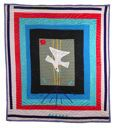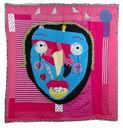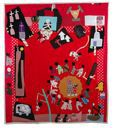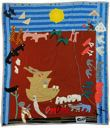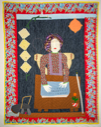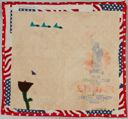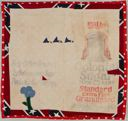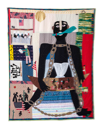Yvonne Wells
American
(Tuscaloosa, Alabama, 1939 - )
December 26, 1939 is the correct birthdate for Yvonne Wells. It has been listed as 1940 in numerous publications. Confirmed in an email to Pamela Bransford on July 23, 2019 by Stacy Morgan, professor in the department of American Studies at the University of Alabama and author of an upcoming biography on Yvonne Wells.
Yvonne Wells was born in Tuscaloosa, Alabama on December 26, 1939. (1) During her childhood, Wells’ mother worked as an elementary school teacher. Wells’ father, a Presbyterian minister, had passed away when she was a girl leaving her mother to raise Wells and her eight siblings. Her mother took education very seriously, and she made sure that all nine of her children received a good education and earned a college degree. (2) Wells always loved the outdoors and during her high school years she became a competitive track athlete. She had dreams of attending a large college where she could train and possibly make the Olympic track team. However, as she was preparing to leave for college she received news that her mother had been diagnosed with cancer. Due to her mother’s illness, Wells decided to attend a smaller college, put her Olympic dreams on hold, and remain close to home. (3) In 1964 Wells’ mother lost her battle against cancer. A few months later, while still dealing with the tragedy of her mother’s death, Wells completed her Bachelor’s degree in Physical Education at Stillman College in Tuscaloosa. After graduating, Wells decided to become a teacher like her mother. In 1965 she became the Physical Education instructor at Druid High School in Tuscaloosa. She worked in this position for the next five years, until, in 1970, Wells was chosen by the district office to teach Physical Education at Tuscaloosa High School. This appointment was made during the integration of public schools in the 1970s. Wells herself was an African American, and her new appointment was in what was previously an all-white school. She saw first-hand the many struggles involved in school integration and the American Civil Rights Movement. Though the initial transition to Tuscaloosa High School was somewhat trying and prejudice in the South ran rampant, Wells overcame the many obstacles and remained in her appointed position for more than twenty years. Also, while teaching at Tuscaloosa High School, in 1973, Wells received her master’s degree in Physical Education. (4) Though Wells became a teacher directly following her graduation from Stillman College, and attained a masters degree shortly thereafter, she also found time to become a wife and mother. Wells married a United States Marine named Livingston, whom she had met while attending college. (5) Together, they had two children, and now have four grandchildren. Today, Wells and her family still reside in Tuscaloosa. Wells retired from her long teaching career in 2000, and began substitute teaching. However, in spring of 2012, she retired completely from teaching in order to have time for other priorities, such as quilting. (6) Wells has never taken any art classes, nor even sewing classes. She has always loved the outdoors and despised anything dealing with indoor “feminine” work. However, in the cold winter months of 1979, Wells was inspired to sew a quilt in order to keep her and her children warm. This was the beginning of Wells’ new hobby. Wells did not realize how much she would enjoy quilting, but that first quilt led to a second, and a third, until it became second nature to her. She became absorbed in her quilting and when she wasn’t teaching or taking care of her family, she was piecing together materials and creating quilts. (7) In the beginning of her quilting career, Wells experimented with different techniques in order to find her preferred technique of sewing. She began by making strip and block quilts, and used several different kinds of fabrics. Soon she began studying patterns from a pattern book given to her by a friend. However, in 1984, after following several patterns, Wells discovered that she did not like following a pattern, as it was not satisfying to her. What made quilt-making enjoyable to her was that she could follow her own plans, use her own ideas, and make decisions based on what she wanted, not on what a pattern told her to do. It was also during this time that Wells experimented some with a sewing machine, which she quickly discovered was also unsatisfying, as she enjoyed sewing by hand so she could feel the material and needle. However, she decided that the sewing machine would be an acceptable tool for hemming her quilts. (8) Wells has always considered herself to be a woman of few words. Wells herself says, “I do not speak, I do.” (9) Throughout her life, Wells has seen many things, especially during the Civil Rights Movement and school integration period, and she feels that these images ingrained in her mind must be recorded in some way. However, instead of speaking vocally, Wells speaks visually through her quilts. It is for this reason that, in 1984, Wells began creating story quilts. (10) These story quilts fall into three categories: religious, sociopolitical, and picture. The religious quilts usually depict a biblical figure or scene, the sociopolitical depict a record of some historical or social event, and the picture usually tell a story learned from life. (11) The first story quilt she created in 1984 was titled Crucifixion and it was based on a biblical reference. This quilt was followed by many other story quilts, all of which commented on topics that Wells felt needed to be addressed or recorded in some way. She felt the need to talk about issues and experiences she had lived through, and the best way she saw to do that was through her quilts. In Wells’ own words “everything I create is like a story, a record of history to benefit people in the future.” (12) Over time, Wells gained a reputation in Tuscaloosa as a quilt maker, and people began donating materials to her cause. Some mornings she would wake up and find several bags on her front porch that were full of materials, buttons, and sewing supplies. Wells would also buy some fabrics and supplies from the store, or use scraps from old or discarded clothing, and in 2000, Wells traveled to France, where she collected buttons and trinkets that she could also use on her quilts. (13) After collecting her materials, Wells begins working on a quilt. In the process of working, she formulates other ideas and images forming a new story, and she then starts on that new idea or quilt as well. Wells can have multiple quilts in progress at one time. Depending on what else is occupying time in her life, each quilt takes approximately three months for her to create. (14) By 1981, Wells had made enough quilts to place an ad in the local newspaper, where she advertised her quilts for sale for only $20. (15) A folk art dealer from Tuscaloosa, Robert Cargo, saw Wells’ ad in the paper, and he and his wife Helen, began making trips out to Wells’ home every Saturday afternoon to look at her quilts. Cargo’s interest in Wells and her work was evident, and he soon became her agent. (16) Cargo convinced Wells to exhibit her work publically, and in 1985 she exhibited at the Kentuck Art Festival located in Northport, Alabama, for the first time. Her quilts were greatly admired at the festival and she was awarded Best in Show not only in 1985, but also in 1990, 1991, 1995, 1997 and 2004. (17) Following her first appearance at the Kentuck Art Festival, Wells continued to create, sell, and exhibit her work and she was even asked to create a Christmas ornament for the Christmas tree at the White House in 1993. Among her many achievements, Wells was honored with the Alabama Arts and Visual Craftsmen Award in 1998. Since her debut in 1985, several prestigious private collectors and museums including the Montgomey Museum of Fine Arts and the Birmingham Museum of Art have acquired her work. Wells’ quilts have been exhibited not only on the local and national level, but also internationally. (18) Each one of Wells’ quilts have certain trademarks. The first of these are three small triangles made of fabric. Wells places these triangular shapes in a row somewhere on the quilt’s surface, usually near the edge of the recto side. She says they symbolize the Holy Trinity. The second trademark is a more recent one in which Wells writes information about the quilt with a permanent marker on the verso side of each piece. The information she writes includes her name, the creation date of the quilt, and its full title. As this is a newer trend for Wells, she is currently going back to her older works and recording the information on the back of each of her quilts. Another trademark is that Wells stitches either her initials or full name and creation date somewhere along the outer edge of the recto side of each quilt. (19) Wells has produced hundreds of quilts, some in series of three if the topic seemed significant enough to her. However, in recent years, her production rate has slowed, which is one reason she is retiring completely from her long teaching career. By removing herself from teaching and other distractions, Wells is hoping to create as many quilts as she can, since she always feels the need to be doing something, to be creating. (20)
(1) There have been several books, articles, and catalogs published on Wells’ work. The information in this essay was compiled from the following sources: Information on file, Montgomey Museum of Fine Arts, Montgomery, Alabama; Just How I Picture It in My Mind: Contemporary African American Quilts from the Montgomey Museum of Fine Arts, Montgomey Museum of Fine Arts, Montgomery, Alabama, 2006; Tara Cady Sartorius, “Soulful Survivor Sewing,” Arts & Activities: The Nation’s Leading Art Education Magazine: 23-24, February 2009; Kemp, Kathy. Revelations: Alabama's Visionary Folk Artists. Birmingham, AL: Crane Hill Publishers, 1994.
(2) Sartorius, February 2009, p. 23-24.
(3) Kemp, 1994, p. 206-208
(4) Sartorius, p. 23-24.
(5) Kemp, p. 206-208.
(6) MMFA Museum Archives, Artists Vertical Files, Wells, Yvonne, Montgomey Museum of Fine Arts, Montgomery, Alabama. This information came directly from Yvonne Wells, recorded during a telephone interview with the artist by the author, conducted on June 27, 2012.
(7) Sartorius, p. 23-24.
(8) MMFA Archives, 2012 Interview.
(9) MMFA Archives, 2012 Interview.
(10) MMFA Archives, 2012 Interview.
(11) Just How I Picture It in My Mind, Montgomey Museum of Fine Arts, 2006, p. 78-79.
(12) MMFA Archives, 2012 Interview.
(13) MMFA Archives, 2012 Interview.
(14) MMFA Archives, 2012 Interview.
(15) Sartorius, p. 23-24.
(16) MMFA Archives, 2012 Interview.
(17) Sartorius, p. 23-24.
(18) Just How I Picture It in My Mind, Montgomey Museum of Fine Arts, 2006, p. 78-79.
(19) MMFA Archives, 2012 Interview.
(20) MMFA Archives, 2012 Interview.
Hannah Ziebach, Curatorial Intern, July, 2012
American
(Tuscaloosa, Alabama, 1939 - )
December 26, 1939 is the correct birthdate for Yvonne Wells. It has been listed as 1940 in numerous publications. Confirmed in an email to Pamela Bransford on July 23, 2019 by Stacy Morgan, professor in the department of American Studies at the University of Alabama and author of an upcoming biography on Yvonne Wells.
Yvonne Wells was born in Tuscaloosa, Alabama on December 26, 1939. (1) During her childhood, Wells’ mother worked as an elementary school teacher. Wells’ father, a Presbyterian minister, had passed away when she was a girl leaving her mother to raise Wells and her eight siblings. Her mother took education very seriously, and she made sure that all nine of her children received a good education and earned a college degree. (2) Wells always loved the outdoors and during her high school years she became a competitive track athlete. She had dreams of attending a large college where she could train and possibly make the Olympic track team. However, as she was preparing to leave for college she received news that her mother had been diagnosed with cancer. Due to her mother’s illness, Wells decided to attend a smaller college, put her Olympic dreams on hold, and remain close to home. (3) In 1964 Wells’ mother lost her battle against cancer. A few months later, while still dealing with the tragedy of her mother’s death, Wells completed her Bachelor’s degree in Physical Education at Stillman College in Tuscaloosa. After graduating, Wells decided to become a teacher like her mother. In 1965 she became the Physical Education instructor at Druid High School in Tuscaloosa. She worked in this position for the next five years, until, in 1970, Wells was chosen by the district office to teach Physical Education at Tuscaloosa High School. This appointment was made during the integration of public schools in the 1970s. Wells herself was an African American, and her new appointment was in what was previously an all-white school. She saw first-hand the many struggles involved in school integration and the American Civil Rights Movement. Though the initial transition to Tuscaloosa High School was somewhat trying and prejudice in the South ran rampant, Wells overcame the many obstacles and remained in her appointed position for more than twenty years. Also, while teaching at Tuscaloosa High School, in 1973, Wells received her master’s degree in Physical Education. (4) Though Wells became a teacher directly following her graduation from Stillman College, and attained a masters degree shortly thereafter, she also found time to become a wife and mother. Wells married a United States Marine named Livingston, whom she had met while attending college. (5) Together, they had two children, and now have four grandchildren. Today, Wells and her family still reside in Tuscaloosa. Wells retired from her long teaching career in 2000, and began substitute teaching. However, in spring of 2012, she retired completely from teaching in order to have time for other priorities, such as quilting. (6) Wells has never taken any art classes, nor even sewing classes. She has always loved the outdoors and despised anything dealing with indoor “feminine” work. However, in the cold winter months of 1979, Wells was inspired to sew a quilt in order to keep her and her children warm. This was the beginning of Wells’ new hobby. Wells did not realize how much she would enjoy quilting, but that first quilt led to a second, and a third, until it became second nature to her. She became absorbed in her quilting and when she wasn’t teaching or taking care of her family, she was piecing together materials and creating quilts. (7) In the beginning of her quilting career, Wells experimented with different techniques in order to find her preferred technique of sewing. She began by making strip and block quilts, and used several different kinds of fabrics. Soon she began studying patterns from a pattern book given to her by a friend. However, in 1984, after following several patterns, Wells discovered that she did not like following a pattern, as it was not satisfying to her. What made quilt-making enjoyable to her was that she could follow her own plans, use her own ideas, and make decisions based on what she wanted, not on what a pattern told her to do. It was also during this time that Wells experimented some with a sewing machine, which she quickly discovered was also unsatisfying, as she enjoyed sewing by hand so she could feel the material and needle. However, she decided that the sewing machine would be an acceptable tool for hemming her quilts. (8) Wells has always considered herself to be a woman of few words. Wells herself says, “I do not speak, I do.” (9) Throughout her life, Wells has seen many things, especially during the Civil Rights Movement and school integration period, and she feels that these images ingrained in her mind must be recorded in some way. However, instead of speaking vocally, Wells speaks visually through her quilts. It is for this reason that, in 1984, Wells began creating story quilts. (10) These story quilts fall into three categories: religious, sociopolitical, and picture. The religious quilts usually depict a biblical figure or scene, the sociopolitical depict a record of some historical or social event, and the picture usually tell a story learned from life. (11) The first story quilt she created in 1984 was titled Crucifixion and it was based on a biblical reference. This quilt was followed by many other story quilts, all of which commented on topics that Wells felt needed to be addressed or recorded in some way. She felt the need to talk about issues and experiences she had lived through, and the best way she saw to do that was through her quilts. In Wells’ own words “everything I create is like a story, a record of history to benefit people in the future.” (12) Over time, Wells gained a reputation in Tuscaloosa as a quilt maker, and people began donating materials to her cause. Some mornings she would wake up and find several bags on her front porch that were full of materials, buttons, and sewing supplies. Wells would also buy some fabrics and supplies from the store, or use scraps from old or discarded clothing, and in 2000, Wells traveled to France, where she collected buttons and trinkets that she could also use on her quilts. (13) After collecting her materials, Wells begins working on a quilt. In the process of working, she formulates other ideas and images forming a new story, and she then starts on that new idea or quilt as well. Wells can have multiple quilts in progress at one time. Depending on what else is occupying time in her life, each quilt takes approximately three months for her to create. (14) By 1981, Wells had made enough quilts to place an ad in the local newspaper, where she advertised her quilts for sale for only $20. (15) A folk art dealer from Tuscaloosa, Robert Cargo, saw Wells’ ad in the paper, and he and his wife Helen, began making trips out to Wells’ home every Saturday afternoon to look at her quilts. Cargo’s interest in Wells and her work was evident, and he soon became her agent. (16) Cargo convinced Wells to exhibit her work publically, and in 1985 she exhibited at the Kentuck Art Festival located in Northport, Alabama, for the first time. Her quilts were greatly admired at the festival and she was awarded Best in Show not only in 1985, but also in 1990, 1991, 1995, 1997 and 2004. (17) Following her first appearance at the Kentuck Art Festival, Wells continued to create, sell, and exhibit her work and she was even asked to create a Christmas ornament for the Christmas tree at the White House in 1993. Among her many achievements, Wells was honored with the Alabama Arts and Visual Craftsmen Award in 1998. Since her debut in 1985, several prestigious private collectors and museums including the Montgomey Museum of Fine Arts and the Birmingham Museum of Art have acquired her work. Wells’ quilts have been exhibited not only on the local and national level, but also internationally. (18) Each one of Wells’ quilts have certain trademarks. The first of these are three small triangles made of fabric. Wells places these triangular shapes in a row somewhere on the quilt’s surface, usually near the edge of the recto side. She says they symbolize the Holy Trinity. The second trademark is a more recent one in which Wells writes information about the quilt with a permanent marker on the verso side of each piece. The information she writes includes her name, the creation date of the quilt, and its full title. As this is a newer trend for Wells, she is currently going back to her older works and recording the information on the back of each of her quilts. Another trademark is that Wells stitches either her initials or full name and creation date somewhere along the outer edge of the recto side of each quilt. (19) Wells has produced hundreds of quilts, some in series of three if the topic seemed significant enough to her. However, in recent years, her production rate has slowed, which is one reason she is retiring completely from her long teaching career. By removing herself from teaching and other distractions, Wells is hoping to create as many quilts as she can, since she always feels the need to be doing something, to be creating. (20)
(1) There have been several books, articles, and catalogs published on Wells’ work. The information in this essay was compiled from the following sources: Information on file, Montgomey Museum of Fine Arts, Montgomery, Alabama; Just How I Picture It in My Mind: Contemporary African American Quilts from the Montgomey Museum of Fine Arts, Montgomey Museum of Fine Arts, Montgomery, Alabama, 2006; Tara Cady Sartorius, “Soulful Survivor Sewing,” Arts & Activities: The Nation’s Leading Art Education Magazine: 23-24, February 2009; Kemp, Kathy. Revelations: Alabama's Visionary Folk Artists. Birmingham, AL: Crane Hill Publishers, 1994.
(2) Sartorius, February 2009, p. 23-24.
(3) Kemp, 1994, p. 206-208
(4) Sartorius, p. 23-24.
(5) Kemp, p. 206-208.
(6) MMFA Museum Archives, Artists Vertical Files, Wells, Yvonne, Montgomey Museum of Fine Arts, Montgomery, Alabama. This information came directly from Yvonne Wells, recorded during a telephone interview with the artist by the author, conducted on June 27, 2012.
(7) Sartorius, p. 23-24.
(8) MMFA Archives, 2012 Interview.
(9) MMFA Archives, 2012 Interview.
(10) MMFA Archives, 2012 Interview.
(11) Just How I Picture It in My Mind, Montgomey Museum of Fine Arts, 2006, p. 78-79.
(12) MMFA Archives, 2012 Interview.
(13) MMFA Archives, 2012 Interview.
(14) MMFA Archives, 2012 Interview.
(15) Sartorius, p. 23-24.
(16) MMFA Archives, 2012 Interview.
(17) Sartorius, p. 23-24.
(18) Just How I Picture It in My Mind, Montgomey Museum of Fine Arts, 2006, p. 78-79.
(19) MMFA Archives, 2012 Interview.
(20) MMFA Archives, 2012 Interview.
Hannah Ziebach, Curatorial Intern, July, 2012
Artist Objects

